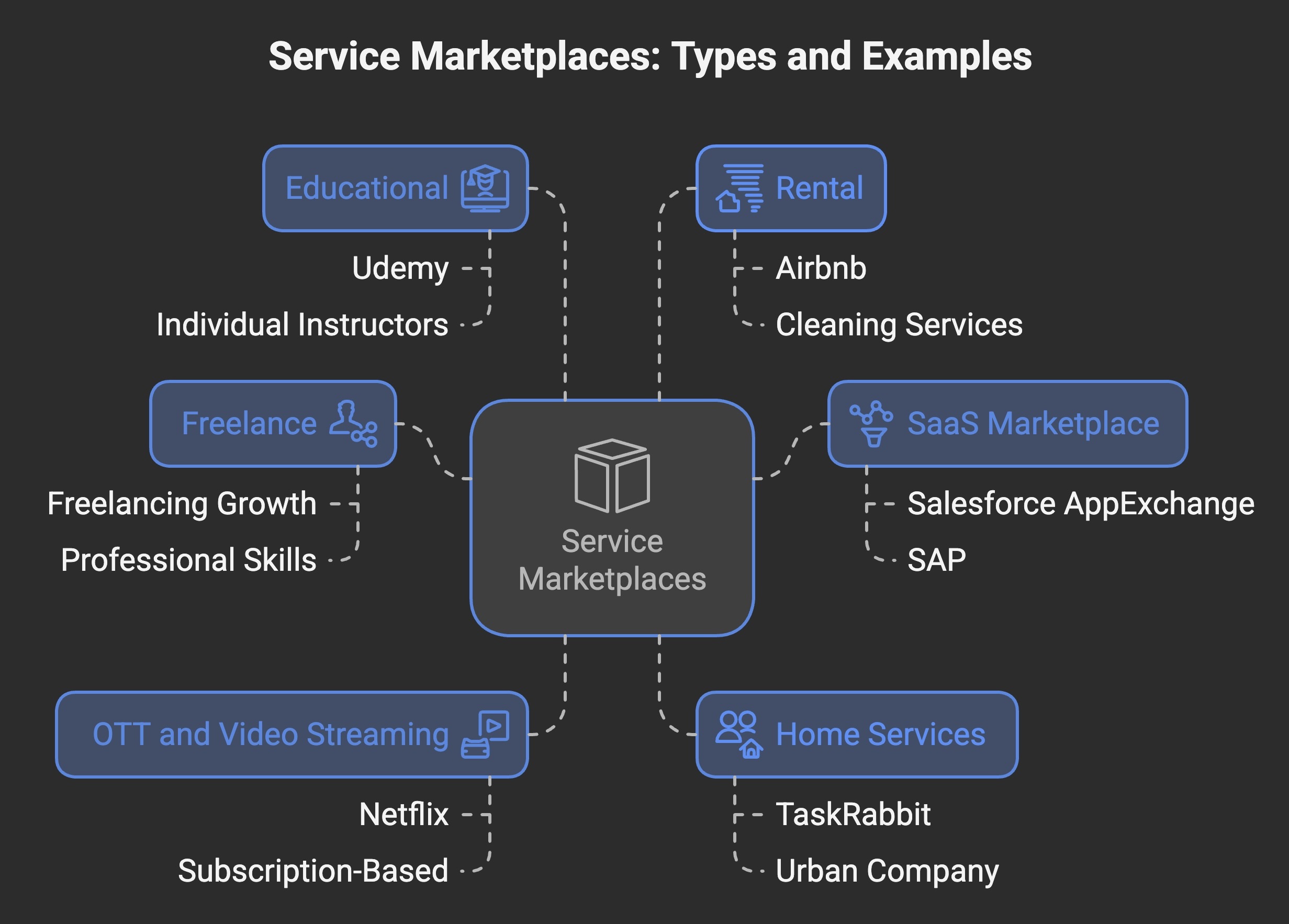Service Marketplaces: What They Are and Why They Matter

Need a plumber in 2 clicks? Or a tutor who fits your schedule instantly? That’s the power of service marketplaces.
Service marketplaces make finding and hiring professionals online easier. Earlier, you would go through phone books, call people, and vet professionals, one by one. Today, online service marketplaces bring everything to one platform.
Whether you require a plumber, graphic designer, or lawyer, it's there to compare and book the same as per your requirements.
It uses revenue models such as commission, subscription, and advertisement. This blog explores what a service marketplace is, its benefits, types, future, and how it generates income.
Understanding Different Marketplaces: Products vs. Services
Every online retail platform can be divided into two types: Product marketplaces and service marketplaces. But some platforms are a hybrid of the two- let’s understand what they are and what tells them apart.
B2B wholesale marketplaces sell physical goods that are sold by professionals. Services are skills and abilities sold to buyers.
An example of a service marketplace is Urban Company. They have professionals offering house cleaning, pest control, massage, spa, and more services. On Etsy, people sell products online.
Swiggy sells products on its Instamart, where you can buy groceries and electronics. However, it also has a marketplace for delivery services called Genie. This makes Swiggy a product as well as a service marketplace.
How Service Marketplaces Work?: An Overview
Service marketplaces are digital platforms connecting providers and buyers. Through these platforms, providers list their services with details, and consumers register to find them and leave reviews.
Such platforms use models like commissions or subscriptions to earn revenue. They don’t have direct transactional revenue since they are the middlemen between providers and consumers. To make up for this, service marketplaces offer value-added services like delivery solutions to save time and make exchanges effortless for everyone.
For example, consider Amazon. It's technically a b2b wholesale marketplace but offers its own delivery service. This way, Amazon earns through delivery charges while buyers and sellers focus completely on their transactions.
Key Benefits of Marketplaces for Service Providers and Consumers
Service marketplaces simplify buying and selling by giving detailed information about both providers and consumers. Let’s see the benefits in detail:
5 Benefits for Service Providers
-
Service providers can reach a larger, more diverse audience without physical barriers.
-
They save on advertising costs, as the platform connects them with clients in need.
-
Providers can give valid information and client reviews to build credibility.
-
Marketplaces manage transactions, reducing the risk of late or missed payments.
-
Many platforms offer tools to track bookings and manage schedules easily.
5 Benefits for Service Consumers
-
Consumers can compare all service providers in one place, saving them time browsing around websites.
-
They can drop reviews and also rate the provider on their profile.
-
They can make a decision with the help of ratings, photos, and reviews dropped by other consumers.
-
Many platforms have transparent pricing with no surprise fees.
-
Consumers can make online bookings and pay securely and conveniently, giving them peace of mind.
Service Marketplaces: Their Models and Types
Service marketplace ranked first in most common merchandise types[1], taking 33% of the credit. This is because these platforms make buying and selling services easy online. They connect users with specific services, meeting diverse needs, from business solutions to personal tasks.
Understanding their models before learning their types will draw a clear picture. Here are the three basic models of service marketplaces:
| Model Type | Description |
|---|---|
| Business to Business | B2B wholesale marketplaces connect businesses for services like SaaS, CRM. |
| Business to Consumer | Businesses offer services directly to consumers, like BigBasket or Zomato. |
| Consumer to Consumer | Individuals offer freelance or personal services to others via platforms. |
6 Types of Service Marketplaces

Let’s explore the six types of service marketplaces and what they offer:
-
Freelance: These platforms help people in need of specific skills find professionals. Freelancing as a service will go up to USD 14.39 billion by 2030.
-
Software as a Service (SaaS marketplace): SaaS marketplaces offer software solutions tailored to various business needs. Examples are Salesforce AppExchange and SAP.
-
OTT and Video Streaming: Platforms like Netflix provide on-demand entertainment to consumers through subscription-based services.
-
Home Services: Platforms like TaskRabbit and Urban Company link users to local providers for cleaning, repairs, or moving.
-
Educational: Sites like Udemy let users buy courses or training from individual instructors or businesses.
-
Rental: Brokers and home renters can list properties and include services, like cleaning and meals, on platforms like Airbnb.
5 Revenue Models that Service Marketplaces are Reshaping

Both e-commerce and service marketplaces earn without offering their own services, relying on commissions, subscriptions, and ads. For example, Urban Company earned USD 99 million by using commissions, leads, auctions, and advertisement models.
Let’s see how these revenue models work and how service marketplaces are reshaping them:
1. Commission
Commission is the most popular business model, with 51.1% out of 100 marketplaces using it. Commission-based platforms charge a percentage that is either fixed or dependent on market competition.
For instance, Airbnb charges a fixed split fee between hosts and renters. Freelancer charges a fee of 3% or ₹150.00 INR (whichever is greater) for employers and 10% or ₹250.00 INR, whichever is greater for freelancers.
2. Subscription
Subscription models involve recurring payments for access. They provide businesses with a steady income and give continuous access to users.
Platforms like Netflix or Spotify use tiered pricing structures, where premium plans unlock exclusive features like ad-free streaming or offline downloads.
3. Memberships
Membership models depend on payments for exclusive benefits. For example, Amazon’s membership model, Amazon Prime, offers benefits like free delivery and special discounts. This builds customer loyalty while providing consistent revenue for businesses.
4. Listings
The listing fee models allow providers to pay to advertise their properties or services on a platform. Real estate websites like 99acres and local service platforms like Craigslist use this model.
For platforms, this model generates revenue without relying on successful transactions. For providers, paying the fee helps them connect with a targeted audience, increasing visibility and reach.
5. Hybrid
Hybrid models combine many business models for added revenue. Platforms like Airbnb use commissions, listing fees, and optional subscriptions. This balances user needs while maximising profits. Hybrid models are a way to adapt to changing demands without relying on one source of income.
For example, software companies provide a “freemium” model to their clients. This is when they use advertising as revenue while also offering a premium, ad-free service for money.
The Future of Service Marketplaces: Trends to Watch Out For
The comfort, flexibility, and technology that service platforms offer have made them a trend in investment opportunities for venture capitalists. Here are some growing trends marketplace investors should keep an eye out for:
-
Artificial Intelligence (AI): AI and machine learning (ML) grow your business through personalised experiences, such as reading user behaviour and suggesting relevant services at discounted prices.
-
Digital Marketing: SEO ranks platforms on search engines, making it easier for users to discover. Digital marketing strategizes ads to help platforms remain competitive.
-
UI/UX: User interface designs create an intuitive experience that keeps customers engaged. Designers build smooth payment gateways that lead to user satisfaction.
How GrowthJockey Can Help You Leverage Service Marketplaces for Growth
At GrowthJockey, we help businesses build service marketplaces that work smoothly and attract users. We help ideate platforms personalised to your needs that focus on easy navigation, secure payments, and fast provider onboarding.
Our team also uses smart tools to track user behaviour and improve your marketplace visibility. We make sure your platform keeps growing with your business, making you a competitor in the industry.
Our solutions will optimise your marketplace growth and save you time and effort so you can improve your business through expert analysis.
Service Marketplaces FAQs
1. What is a service marketplace?
A service marketplace is an online site where providers can sell their services, such as home cleaning, SaaS marketplace, streaming, tutoring, consultancy, etc. This connects them to the users and makes searching and transactions easier.
2. How do you create a service marketplace?
To build a service marketplace, you need to find your target audience. Design a user-friendly platform with secure payment features and an intuitive interface. Focus on provider onboarding, customer reviews, and transparent pricing.
3. What is the SAP service marketplace?
SAP service marketplace is a platform offering enterprise software solutions and support. Businesses use it for tools, updates, and resources to manage operations.
4. How do you create an OSS in SAP?
Creating an online support system in SAP involves setting up a connection for software issue resolution. Log in to the SAP Service Marketplace, register your system, and create a support request (OSS Note).








